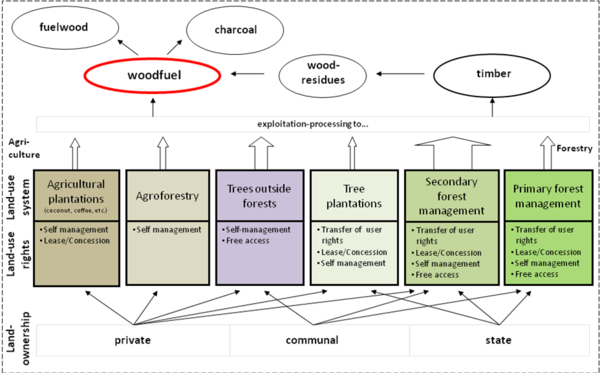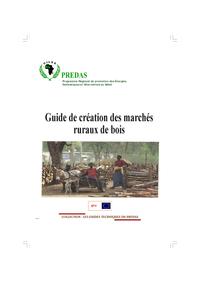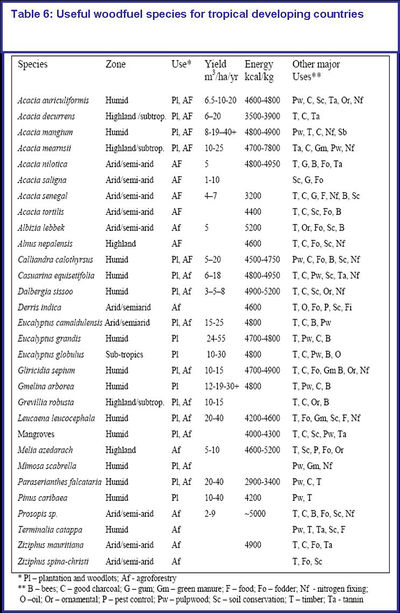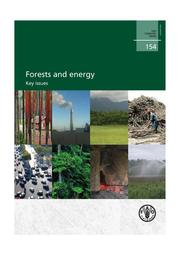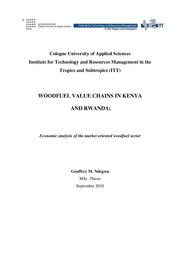Woodfuel Production Options
Cooking Energy System | Basics | Policy Advice | Planning | Designing and Implementing ICS Supply | Designing and Implementing Woodfuel Supply | Climate Change | Extra
Sources of Woodfuel
Woodfuel originates from a wide range of land-use systems. These including agricultural plantations, agroforestry, trees outside forest, tree plantation, secondary forest management, and primary forest management (see table below). The manner in which wood for energy use is produced of course depends on climatic conditions, vegetation cover, local demand, and infrastructure. But it also depends crucially on land ownership (either prviate, communal, state) and land-use rights (including self management, free access, lease, and transfer of user rights) See the figure below for an illustrational overiew.
Figure: Origins of woodfuel[1]
Forest Energy Plantations
Planted forests, established through afforestation or reforestation, have a particularly important role to play in providing a renewable and environmentally friendly energy resource.
They can play a positive role in:
- Providing ecosystem services, such as preventing erosion, protecting soil and water, and storing carbon etc.
- Reducing pressure on natural forests
- Restoring marginal or degraded land
- Providing rural employment and development
Currently, there are about 109 million hectares of productive forest plantations in the world. For more information see FAO (2006) "Global Forest Resource Assessment 2005".
In the past, energy plantations were often ill-designed and suffered from insufficient health, vitality, productivity and lacked return on investment. In addition, they were often subject to social and land use conflicts. Many of the plantations failed due to poor management, lack of know-how, and the low commitment of staff in the public forestry services.
Furthermore, there is much controversy about the topic of introduced species versus native specis. It is clear that plantations can be detrimental to biodiversity especially when they are established at the expense of original indigenous forest habitats. Native species should always be given priority. However, the failure of many native species in planting trials regarding growth, resistance to pests, etc, is one of the reasons hindering the wider use of native trees in land rehabilitation. This is often linked to the fact that information on the phenology and silvicultural techniques is lacking, making large scale production in many cases more difficult than with exotics.
With increasing pressure on natural forests, alternative sustainable approaches are needed to keep pace with the growing demand for woodfuel. Rising oil prices keep people from climbing the energy ladder, thus increasing their dependence on woodfuel. Consequently, forest plantations need careful development policies, with public sector dominance giving way to more private sector participation, and integrating with other sectors and approaches to provide a sufficient supply of woodfuel.
The Food and Agriculture Organization of the United Nations (FAO) has coordinated a multi-stakeholder process between 2004 and 2007 to balance the social, cultural, environmental and economic dimensions of planted forest management and to support their contribution towards sustainable livelihoods and land use through voluntary guidelines for planted forests. These guidelines are tailored primarily to governments, public- and private-sector investors, policymakers and planners. See link below.
-> Responsible Management of Planted Forests: Voluntary Guidelines
Generally, the establishment of plantations on pristine or almost pristine forest lands is not recommended. Hardwood species generally have the greatest potential for woodfuel. The type selected should coppice readily, be a variety that fixes nitrogen, and be a multi-purpose species (meaning a species which can serve several purposes, such as providing fruits, habitat, shade, or soil improvement). Selection also depends on what can be grown easily on the site and what is acceptable to the users. Cultivation methods should be adapted to the skills and resources of the rural people. Care in the establishment phase is very important. Every plantation activity should be preceded by an economic analysis. Sustainability can only be assured when the returns on investment are significant for the plantation owner and have a positive social and ecological potential.
-> The following excel-based program (in French) allows users to quickly determine the economic viability of woodfuel plantation programmes:Guide de l'utilisateur du modèle "Analyse Financière"
In Madagascar, GIZ adopted a village-based approach of making local people the centre of planning and implementation of woodfuel plantations. Individuals are given the property rights of degraded community land for reforestation. The project provides institutional and technical support, and the soil is initially prepared by tractor before handover. The plantation owner is responsible for raising seedlings and maintaining the plantation. An overall GIS based monitoring system gives data on each and every plantation plot, including productivity figures, income generated, etc. To date (2011), more than 6500 hectares have been planted in Madagascar, providing an increase in income of more than 20% for more than 2000 rural households.
-> The approach is described in the brochure:Le reboisement villageois individuel
Also noteworthy is an approach known as “rainforestation farming” in which native or local trees are used to rehabilitate degraded landscapes and restore key ecosystem services and functions, while providing forest-dependent communities with an alternative source of livelihood. This system was developed in the 1990s with support of GIZ and in collaboration with the Visayas State University in the Philippines and is currently being increasingly propagated throughout the country and beyond.
-> Further information can be obtained at the following internet site: Rainforestation:Return of the Natives
Another type of scheme known as the ‘outgrower scheme’ is a relatively new development in the African forestry sector. It entails companies entering into long-term partnerships with small growers. The companies provide financing (loans) and inputs such as seedlings and extension support for the establishment and maintenance of the woodlots. For the companies, these schemes address the need to develop long-term timber/woodfuel supplies without tying up large amounts of capital in land holdings when all they require is wood. The outgrower scheme is described in more detail in the following FAO report from 2001:
-> Forestry Out-Grower Schemes: A Global View
Management of Natural Forests
Management of natural forests is a very complex undertaking in areas where the supply of woodfuel is usually a by-product of more valuable products such as timber, poles etc.
Woodfuel shortages generally occur in regions where savannah-type vegetation is predominant due to low and erratic rainfall patterns. These savannah woodlands are not well suited for high-value timber production, although they may make a major contribution to non-timber forest products such as fodder, gums, resins, etc.
The sustainable management of using these savannah woodlands for fuel is often described as Participatory Forest Management (PFM) or Community based forest (natural resources) management.
PFM experienced a particular impetus due to increasing decentralization efforts, in which management responsibility over state-owned forests is increasingly being transfered to local communities. In order to implement a PFM approach and to get local people to invest in sustainable forest management, issues around land tenure and the secure transfer of decision-making powers from central government to local institutions have to be resolved.
-> Recommendations and potential pitfalls around decentralization of natural resources management are described in a publication of the ‘The World Resources Institute’ Democratic Decentralization of Natural Resources
|
Manuals on Participatory Forest Management -> The CILSS-based project PREDAS published a amenagement forestier villageois.pdf amenagement forestier villageois.pdf amenagement forestier villageois.pdf manual on community based forest management for woodfuel production for energy. -> A Steps in Establishing Participatory Forest Management.pdf field manual explaining the key steps of establishing Participatory Forest Management in Ethiopia has been put together as the result of ten years’ practical experience by FARM-Africa and SOS Sahel Ethiopia. -> UNHCR published a guide on forest management practices to react on some degree of forest degradation and deforestation in the refugee and returnee context. |
The following features were found to be particularly important when designing and implementing PFM projects for energy supply:
- PFM activities should take place after stakeholder consultations to enhance awareness of the causes and consequences of uncontrolled exploitation and the benefits of available techniques for forest rehabilitation.
-> Example of an animation tutorial for awareness campaigns: des villages verts. Guide de l'animateur
- Baseline studies are fundamental tools for assessing success or failure of intended PFM activities.
-> Example of different tools and techniques to facilitate collection and analysis of information: PARTICIPATORY RURAL APPRAISAL FOR COMMUNITY FOREST MANAGEMENT
- Distribution of power and responsibility by the government services (forest department) to the community requires critical analysis and informed public debate. It depends on the ownership of forest land (public, community or private). Equitable sharing of costs and benefits within the communities and between the communities and the government have to be clearly defined. The results should be recorded as an agreement, providing the basis for PFM activities.
-> Example of a local agreement: Les conventions localesUn outil fonctionnel dans la gestion forestière decentralisée
- Functional institutional frameworks at village level to oversee planning, implementation and monitoring have to be established. Such a local management structure should be governed by the Community or Village Assembly. Clear guidelines have to be developed to specify the responsibilities of each and every member within the local management structure.
-> Example of the institutional framework of a local management structure: Manuel pour la mise en place des structures locales de gestion (SLG)
- Forest management plans must be simple and short and should be developed through participatory action in a way that is accessible for communities where literacy levels are low. To foster local ‘ownership’ of such a management plan, the contents of the plan must include the knowledge, experience and expectations of the local community about their forest.
-> General Guideline to establish simple forest management plans
-> Example of a manual for simple management plans for woodfuel production in Chad: Instruction pour l'élaboration des Plans de Gestion Forestière Simplifiés au Niveau des Villages VERTS
- In open access areas, sustainable forest management competes with uncontrolled exploitation (where the woodfuel price does not reflect any replacement costs). In these situations, communities investing in sustainable forest management tend to lose their motivation and give up because of lack of incentive. The introduction of a differential tax system is essential to provide a fiscal incentive to firewood traders who access their fuel from sustainably managed forests rather than from the uncontrolled exploitation of natural woodlands. An effective control system has to be put in place to enforce the differential tax system or it fails to work and has no impact.
A good example of a successfuel PFM for energy is the introduction of rural woodfuel markets (RWM) in Africa (e.g. Niger, Mali, Madagascar, Senegal). A RWM is a place where woodfuel dealers can buy firewood and charcoal drawn from an area of natural woodland formally delimited and agreed between the villages and the local authorities. This woodland area is managed using a simple plan agreed between the village associations and the local forestry service. It includes:
- an annual woodfuel quota that stays below the annual production rate (safety margin)
- a set of very simple silvicultural and woodfuel cutting rules. Rural woodfuel markets are run by a local management structure. The CILSS-based EU-supported project PREDAS has published a guide on how to create woodfuel markets.
Guide de création des marchés ruraux
In Ethiopia, a PFM approach called WAJIB has been developed with GIZ support in which a binding agreement is made between the local forest user groups and the district forest office. There are clearly defined rights, duties and obligations for both partners. This approach differs from many other PFM approaches in Africa as the number of participating households is limited by the forest carrying capacity and the economic potential. The underlying assumption is that households will only invest in forestry operations if they can make a living out of sustainable forest management. Thus, the forest in a given village is subdivided into forest blocks with an average size of 360 hectares. Based on the forest carrying capacity of 12 hectares per household, each block is managed by a WAJIB group of not more than 30 households. Each WAJIB group has its own internal regulations (by-laws), which govern the use, protection, rights and responsibilities of each household within the block. The main duty of the forest administration is to provide technical advice to the WAJIB groups on how to develop and utilize the forest on a sustainable basis.
The following documents describe the WAJIB approach:
In Southern Africa, the miombo woodlands are the major sources of fuel. Miombo woodlands are tropical and subtropical grasslands, savannas, and shrublands. These woodlands provide a wide range of products (including timber) and services to rural households, so the forest management approaches need to be very diverse and often embedded in an integrated land use approach. The opportunities and barriers to sustainable management of miombo forests are described in the CIFOR publication Woodlands – Opportunities and Barriers to Sustainable Forest Management 2007.
By harvesting woodfuel, people make an impact on the state of their forests. The impact of these activities on the environment is hard to predict. Ecological monitoring is more and more recognized as a helpful method in natural resource management. The following manual, which discusses community-based ecological monitoring, gives advice to the practitioner of how to conduct such an activity: Community Based Ecological Monitoring.
Trees Outside Forests (TOFs)
Trees outside forests (TOFs) include all trees found on non-forest and non-wooded lands, such as agricultural lands, in urban and settlement areas, along roads, in home gardens, in hedgerows, scattered in the landscape and on pasture and rangelands. Most knowledge on TOFs comes from experience in agroforestry. Agroforestry is the practice of growing trees and agricultural products on the same piece of ground, and at the same time. <Agroforestry helps farmers create more integrated, diverse, productive, profitable, healthy and sustainable land-use systems.
Although TOFs fulfil a multipurpose function, and are part of an integrated land-use system, woodfuel can be a main product. The FAO (2001) cites references in the Asia-Pacific area, where over two-thirds of the energy demand is supplied by fuelwood from non-forest sources, providing fuel for two billion people.
Trees for fuelwood can be planted dispersed, in a row, on crop land (alley cropping), in home-gardens, as replacement, or by the introduction of selected trees or shrubs to enhance natural fallow vegetation. To control soil and water erosion, trees and shrubs are planted as living barriers along the contour lines of a slope or terrace. Living fences planted as lines of trees on farm boundaries or on pasture plots, animal enclosures or around agricultural fields can contribute to the energy supply of local households. The Agroforestry extension manual for Kenya provides an excellent overview of the different approaches, illustrated by a number of case reports.
-> Agroforestry Extension Manual for Kenya(1994)
As with forest energy plantations, hardwood species that coppice readily and fix nitrogen should be selected (see Table 6) . They should be fast growing hardwoods which can be harvested after 4-6 years, well-adapted to the site, easy to grow, and resistant to goats and wildlife damage. The World Agroforestry Centre maintains a freely accessible database providing information on the management, use and ecology of a wide range of tree species that can be used for fuelwood in agroforestry.
Lack of accessible fuelwood supplies often affects women the hardest. Thus, it is important to integrate their concerns when designing agroforestry projects. The World Agroforestry Centre published a guide on how to integrate gender issues when programming agroforestry initiatives in the Sahel.
-> Intégration du genre dans la mise en œuvre d’un programme agroforestier au Sahel : Guide pratique des chercheurs
The Sahel Eco-Farm (SEF) approach to agroforestry has been developed with the support of ICRISAT. It is a good example of an agroforestry-based system combining ecological advantages (such as improving microclimate) and soil conditions, with income generation. This approach improves the livelihoods of the rural poor in vulnerable regions such as the Sahel. The SEF is based on an alley cropping system, in which trees and/or shrubs are intercropped with annual crops.[2]
A good example of increasing fuelwood supply is by planting nitrogen-fixing trees that can be harvested for fuelwood or charcoal after 3-4 years as part of a system to improve fallow fields. In Chapter 6 of a recent publication by the World Agroforestry Centre on innovative agroforestry approaches, an improved fallow system is described. See:
-> World Agroforestry into the Future
Enough wood can be obtained from one hectare of improved fallow to supply the fuelwood needs of a typical 6–7 member rural household for 6–8 months.
Another key initiative is to promote agroforestry at policy level so that it is recognized as one of the most important fuelwood supply resources, besides natural forests and plantations. The socio-economic and ecological advantages of agroforestry substantially outweigh many expensive, ill-conceived tree plantation programmes. Agroforestry can be developed at a fraction of the cost of large-scale plantations, and the approach encourages greater local participation and a wider diversity of goods and services for the local and national economies.
Further Information is provided by following internet sites:
Table 6: Useful woodfuel species for tropical developing countries[3]
Further Information
|
Further information on wood energy issues can also be found on the recently launched FAO internet site.
| |
| Criteria and indicators for sustainable woodfuels
FAO: 2010 This publication assesses the environmental, social and economic issues as |
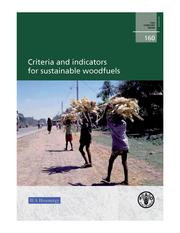
|
|
Key Issues about Forest and Energy FAO: 2008 General overview of different options to use forest products for energy consumption. |
|
|
The German perspective on wood energy was discussed during an expert meeting in 2010 at GIZ headquarters. German institutions working in the field of wood energy came together for this half-day meeting. Responsible: GIZ HERA |
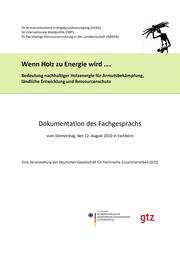
|
|
Wood – A source of supply for sustainable energy Published by GIZ-HERA – Poverty-oriented Basic Energy Services |
|
|
Woodfuel Value Chains in kenya and Rwanda Economic analysis of the market oriented woodfuel sector Author: Geoffrey M. Ndegwa (MSc. Thesis, Cologne, September 2010)
This research highlights the potential in the woodfuel sector to play a key and significant role in the rural and urban poor economic development of Rwanda and Kenya. |
|
|
The wood energy value chain - Opportunity for Development - Author: Cornelia Sepp - ECO-Consult |
|
References
This article was originally published by GIZ HERA. It is basically based on experiences, lessons learned and information gathered by GIZ cook stove projects. You can find more information about the authors and experts of the original “Cooking Energy Compendium” in the Imprint.
- ↑ S. Sylla (GIZ HERA), S. Sepp (Eco Consult)
- ↑ The Sahelian Eco-Farm: http://www.worldwidewattle.com/infogallery/utilisation/sehelian-eco-farm.pdf
- ↑ Agroforestry: http://www.worldagroforestry.org (based on National Academy of Sciences 1980, 1983, Nair 1993, FAO 2000, FFRD, 1994)


